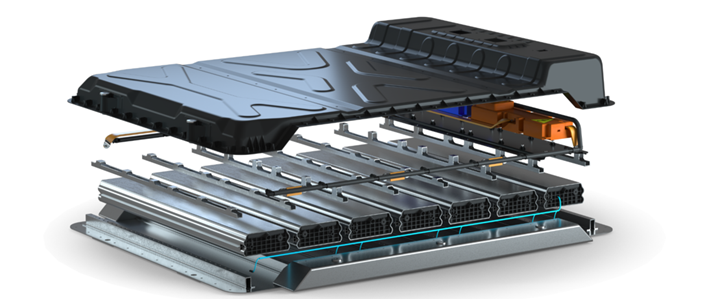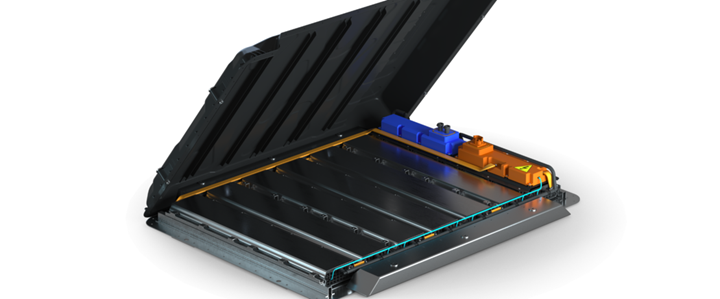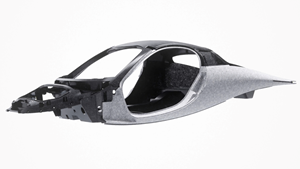
Evonik-led consortium EV battery housing with epoxy SMC cover. Photo Credit: Evonik
Evonik Industries (Essen, Germany) reported in February 2021 that it is leading a consortium partners that have developed a lighter and more cost-effective high-voltage battery housing concept for e-mobility solutions using glass fiber-reinforced epoxy sheet molding compound (SMC). The holistic battery system concept is designed to offer the automotive industry a safer and more energy efficient alternative to metals or higher priced carbon fiber-reinforced plastics (CFRP).
The consortium includes Evonik, design specialist Forward Engineering (Munich, Germany), battery technologist LION Smart (Garching, Germany), compounder and fabricator Lorenz Kunststofftechnik (Wallenhorst, Germany) and engineering services and business development specialist Vestaro (Munich, a joint venture of Evonik and Forward Engineering) and, most recently, MINTH (Jiaxing City, China), a global manufacturer of EV battery housings and other automotive structures.
The composite battery housing concept developed by the consortium can be used for three battery sizes: 65 kilowatt-hours (kWh), 85 kWh and 120 kWh for use in various vehicle sizes and class. CW spoke with engineers from Evonik and Vestaro to learn more about the consortium, the epoxy SMC, the housing design and the consortium’s go-to-market plans.
Sebastian de Nardo, manager applied technology ECA composites and adhesives at Evonik, says the genesis of the battery housing spans back several years. Evonik, he says, recognized in the broader composites market a need for an epoxy SMC that would reduce VOC exposure, process quickly and easily, reduce weight and provide performance and mechanical properties better than standard SMC.
This led first to Evonik’s development of VESTALITE S, a new amine-based epoxy hardener that, says de Nardo, enabled many of the attributes sought in an epoxy SMC. VESTALITE S is, he says, compatible with any epoxy and improves viscosity, reactivity and glass transition temperature (Tg). It also offers a fiber volume fraction (FVF) of up to 65% and low residual shrinkage through the B-stage. Evonik worked with compounder Lorenz Kunststofftechnik on development of the epoxy formulation with the VESTALITE S hardener, and then turned its attention to finding an application.

Battery housing assembled, with cover open. Photo Credit: Evonik
Evonik, says de Nardo, identified e-mobility battery housings as a good option given the demanding mechanical, weight and cost requirements. The company eventually connected with battery technology firm LION Smart and, working with Forward Engineering, began design of a housing to enclose and protect LION Smart’s battery technology.
The resulting design, says de Nardo, is completely novel and checks off several features that, Evonik hopes, will make the housing a good fit for e-mobility OEMs. Such features include simplicity, scalability, minimal parts count and ease of assembly. “We wanted to keep the system quite simple to demonstrate the capability of SMC,” de Nardo says. Design specifics of the housing include a flat aluminum bottom, penthouse geography in a glass fiber/epoxy SMC top cover, molded-in structural ribs, molded-in inserts, molded-in mounting points and easy cover sealing during assembly.
The battery technology the housing encloses, developed by LION Smart, is called the LION Light Battery. It consists of multiple Supercells. Each Supercell is immersed in a dielectric coolant, which provides a low average operating temperature that extends battery life. This technology requires integration of a coolant pump within the housing and a heat exchanger outside the housing, which the design accommodates. The modularity of the LION Light Battery design allows expansion up to 120 kWh, and with further design adjustments it can be extended to accommodate high-energy EVs, such as buses and trucks, which typically require 200-kWh systems.
Evonik worked with Vestaro to validate of processability of the epoxy SMC housing. Philipp Taschner, project engineer at Vestaro, says the company manufactured several hardware demonstrators in an already existing complex SMC tool to validate the processability of the material under real life conditions. The demonstrator housings were produced in a Dieffenbacher (Windsor, Ontario, Canada) press. The mold was developed by Lorenz Kunststofftechnik, which likely will manufacture the housing if and when it enters production. Taschner says the reaction time of the epoxy SMC was about 3 minutes at 150°C. VOC emissions, which are typically 969 μg/g for vinyl ester SMCs, were just 9 μg/g for the epoxy SMC, with no styrene emissions.
As noted, the housing is available in three configurations. The 65-kWh system provides 400V and weighs 412 kilograms. The 85-kWh system provides 400V and weighs 528 kilograms. The 120-kWh system provides 800V and weighs 790 kilograms. The structures for each configuration comes from the same tooling, which is scalable in the x and y directions.

Comparison of insulation performance between aluminum cover and epoxy SMC cover. Photo Credit: Evonik
The finished housing was tested it in a variety of service environments; results were overwhelmingly positive. The housing is 9.8% lighter than other SMC-based enclosures, provides side-impact protection up to 350 kilonewtons and good thermal insulation properties. Thermal performance was particularly strong. After exposure to direct heat of 800°C for 10 minutes, the housing suffered no burn-through, had a maximum outside temperature of just 350°C, and had a measured mechanical strength of 1.9 MPa.
With a mechanically and thermally viable product in hand, and with a process that can accommodate relatively high manufacturing volumes, Vestaro is now working with e-mobility OEMs inside and outside of Europe, as well as automotive Tier 1 suppliers, on implantation in a production vehicle. If and when this housing comes to fruition in a commercialized vehicle, Taschner from Vestaro expects the design will be modified to meet the working envelope and requirements of the powertrain itself. “We would adjust this concept to the requirements of the OEM,” he says, adding that the addition of MINTH to the consortium provides “expertise in metal structures and large-scale production. They add great value to the already existing partnership.”
For more information on the Evonik-led battery housing design, contact de Nardo directly at sebastian.denardo@evonik.com, or Taschner at philipp.taschner@vestaro.com.
Related Content
Aptera joins forces with C.P.C. Group to accelerate solar EV production
Specialized composite bodies are being produced in Modena, Italy, for Aptera’s BinC vehicle, enabling eventual manufacturing ramp-up of 40 vehicles/day to meet demand targets.
Read MoreAOC introduces UV-Resistant Automotive System for SMC parts
AOC’s novel formulation, tested in the lab and in real-world environments, delivers a deep black, molded-in color that resists fading and offers high scratch resistance.
Read MoreComposite materials, design enable challenging Corvette exterior components
General Motors and partners Premix-Hadlock and Albar cite creative engineering and a move toward pigmented sheet molding compound (SMC) to produce cosmetic components that met strict thermal requirements.
Read MoreSMC composites progress BinC solar electric vehicles
In an interview with one of Aptera’s co-founders, CW sheds light on the inspiration behind the crowd-funded solar electric vehicle, its body in carbon (BinC) and how composite materials are playing a role in its design.
Read MoreRead Next
Plant tour: Daher Shap’in TechCenter and composites production plant, Saint-Aignan-de-Grandlieu, France
Co-located R&D and production advance OOA thermosets, thermoplastics, welding, recycling and digital technologies for faster processing and certification of lighter, more sustainable composites.
Read More“Structured air” TPS safeguards composite structures
Powered by an 85% air/15% pure polyimide aerogel, Blueshift’s novel material system protects structures during transient thermal events from -200°C to beyond 2400°C for rockets, battery boxes and more.
Read MoreDeveloping bonded composite repair for ships, offshore units
Bureau Veritas and industry partners issue guidelines and pave the way for certification via StrengthBond Offshore project.
Read More























